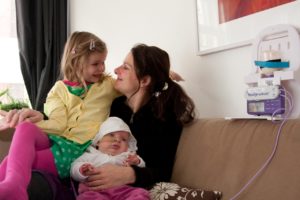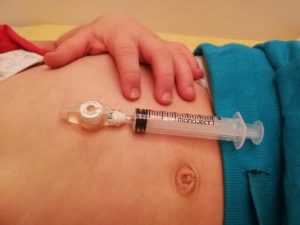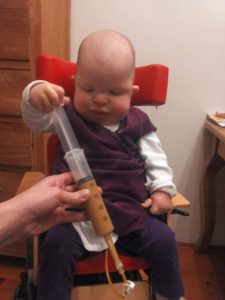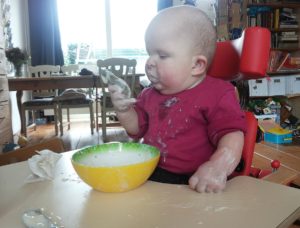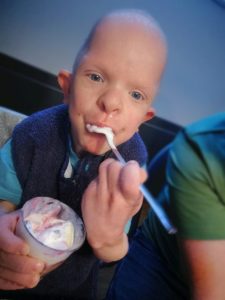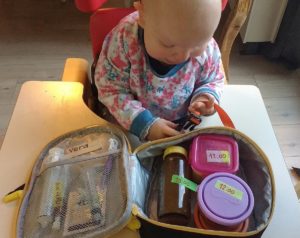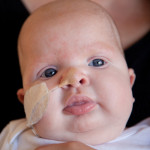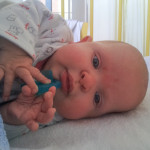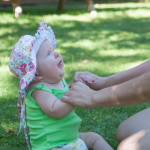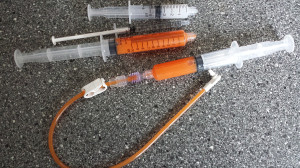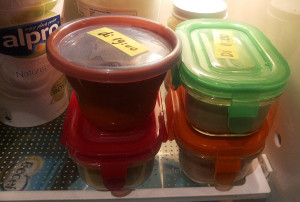Eight years ago, now. I still remember how surprised I was that my baby couldn’t eat. And how sad I was about that. Food is so much more than sustenance – food is also: togetherness, sharing, smelling, tasting, enjoying, discovering, quenching hunger, growing, celebrating…
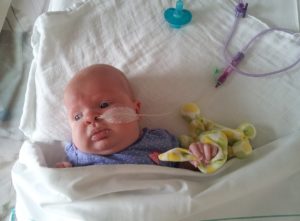
A couple of hours after Vera’s birth, a feeding tube was put in from her nose to her stomach. After a couple of months, that feeding tube was replaced by a port in her belly that connects to her stomach. These feeding tubes were her lifeline because, like most children with Costello Syndrome, Vera wouldn’t eat. She tried, but her fine motor skills and sensory issues got in the way. Her cell signals are different and do not send a message to the brain that food is needed to survive. Tube feeding was the only way for years.
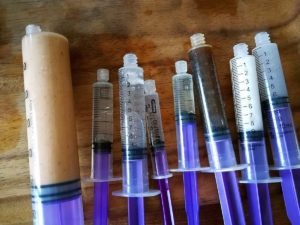
We have gone through quite a journey in this with Vera. For those who know us or have been reading along with us, you may remember we went from pumped breast milk through the feeding tube to special tube feeding formula that caused vomiting and diarrhea, to discovering the blended diet: simply putting our daily meals in the blender and using syringes to feed Vera. This brought an enormous improvement in Vera’s quality of life. She received real food through the feeding tube, precisely the same healthy food we were eating. Seriously, when I start talking about the blended diet, I sound like a total spokesperson. And in the meantime an entire team of therapists worked alongside: pre-speech and speech therapy (yes, speech therapists do not only help with speaking but also with learning to eat: the movement of mouth and tongue are crucial in learning how to eat), there were play sessions with food and Vera did all sorts of exercises to learn to deal with different textures.
When you have a child with disabilities, you quickly discover how complex seemingly simple and mundane everyday tasks can be. Learning to eat proved to be this complex system of feeling hunger, smelling food, tasting food, feeling brave enough to touch food, being able to endure the textures of food in your mouth, making the right movement with your tongue, chewing and swallowing and all of this without gagging or choking. And then to keep eating and not be done after just a couple of bites. Vera has also had feeding therapy at school. She would go to a special room and practiced eating one bite of a sandwich and then would return back to class. As parents, we also received great support from the EAT-team at Rijndam rehabilitation.
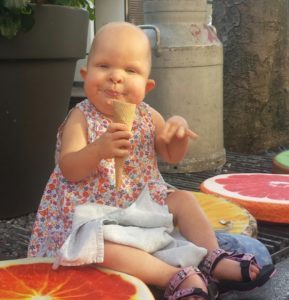
There were lots of fun moments: we may have gone to the gelato place in town way too often over the course of a couple of summers because ice cream was just about the only thing Vera enjoyed eating. There were some tricky moments: Vera could eat an entire piece of cake with whip cream at a birthday party, but when we tried handing her a boiled egg at home, she would gag. When she really wanted to join us in eating our dinners together, but simply couldn’t and would get frustrated. It was a long and slow process with some steps forward, but then with illness, a big slide backwards again.
But we were making progress. At a certain point, she got enough food in her so she no longer needed a tube feeding at school. In the mornings and evenings, she would still receive healthy homemade tube feedings with lots of vitamins to round out her caloric intake.

And then came the big stay at home period due to COVID-19. After some initial confusion, Vera seemed to be doing well with staying at home so much. Everything was very predictable, the family was always complete and Vera had more energy. To our big surprise, she used this energy to focus on eating. Eating more, eating new things and crucially, eating a big enough dinner. There were days with some trepidation that we could skip the evening tube feeding because she really did eat a decent amount of food. Days where we could skip the morning tube feeding because she ate enough breakfast. And suddenly we realized she hadn’t had a tube feeding in 5 days. All of a sudden, a week in which we didn’t use the blender to make tube feedings. And 5 days turned into 5 weeks without feeding Vera through her Mickey-button in her stomach. What a milestone! Even some of her medication Vera now swallows on her own. Some other meds are still too difficult (a pill that is too large and liquid heart medication that is critical and has to be an exact dosage).
There are still some bumps in the road here and there. But currently, we no longer regard Vera as a tube fed child, but as a difficult eater. Like with many children: fruits and vegetables are the hardest and we use tricks like hiding them in soup or muffins or with some whip cream on a banana. But that is okay, it is a new phase. Vera still has to gain lots of experience in eating normally. But it is good enough. And good enough is fantastic.
For now, the mickey-button in her stomach stays where it is. We like to see how things will progress for a couple of months. To really see and experience that this is the new normal. And we will also have to see how things will go when she is tired, ill or tense. Whether things will continue to go well, and we can really start living without tube feedings. Vera has had the mickey-button for eight years now. It’s a part of her and we don’t need to get rid of it just yet. Vera also perceives it as a necessary part of her body even though she has now asked us a couple of times whether it can come out. Regardless: I think it’s time for a return trip to our local gelato place or for cake because we definitely have something to celebrate!

